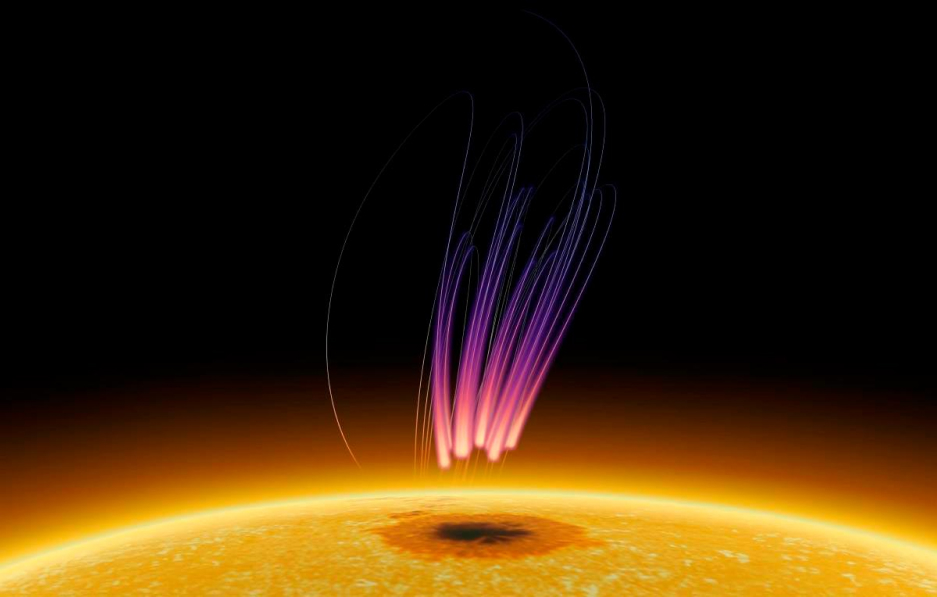New Discoveries: Unexplained Radio Emissions Resemble Aurora Above a Sunspot

A team of scientists has conducted research and discovered extended radio emissions above a sunspot, similar to those previously witnessed in the polar regions of planets and certain stars, thereby potentially enriching our knowledge of severe stellar radio eruptions. Attribute: Sijie Yu
At the New Jersey Institute of Technology, researchers have gauged extraordinary, prolonged radio emissions from a sunspot, contributing to further understanding of magnetic phenomena in solar and stellar environments.
The research, which was published in Nature Astronomy, contains detailed radio observations of an extraordinary aurora-like manifestation above a rather dark and cold area on the Sun known as a sunspot, which was recorded by astronomers from the New Jersey Institute of Technology’s Center for Solar-Terrestrial Research (NJIT-CSTR).
According to the researchers, the exceptional radio emission holds resemblances to the auroral radio emissions frequently witnessed in planetary magnetospheres around Earth, Jupiter, and Saturn, as well as certain low-mass stars.
Sijie Yu, the research's lead author and a scientist at NJIT-CSTR, says that this discovery offers deeper insights into the origin of such intense solar radio bursts and could potentially unlock new methods to understand similar phenomena in distant stars with large starspots.
“We’ve captured an unusual type of prolonged polarized radio eruptions originating from a sunspot, which lasted for over a week,” Yu stated. “This is unlike the typical, short-lived solar radio bursts that usually last for minutes or hours. It’s a thrilling discovery with the potential to modify our understanding of stellar magnetic processes.”
Famous auroral light displays occurring across Earth’s polar region skies, such as the Northern Lights or Southern Lights, occur due to the disturbance of Earth’s magnetosphere by solar activities. Consequently, charged particles are caused to precipitate to Earth’s polar region whereby magnetic fields converge and interact with oxygen and nitrogen atoms in the high atmosphere. Such electrons accelerating towards the north and south poles can lead to intense radio emissions at frequencies around hundreds of kHz.
The research team maintains that the newly detected solar radio emissions, captured over a wide sunspot region temporarily formed where the Sun’s surface magnetic fields are particularly high, materially differ from previously known solar radio noise storms both spectrally and temporally.
“Our investigation suggests that the radio emissions are the result of electron-cyclotron maser (ECM) emission, involving energetic electrons trapped within converging magnetic field geometries,” Yu clarified. “Sunspots' low-temperature and intensely magnetic regions provide conducive conditions for ECM emission, thereby drawing parallels with the magnetic polar caps of planets and other stars and potentially providing a local solar analog to study these phenomena."
“However, in contrast to Earth’s auroras, these sunspot aurora emissions occur at frequencies ranging from several hundred thousand kHz to roughly 1 million kHz, resulting directly from the sunspot’s magnetic field being thousands of times more intense than Earth’s.”
The timing of these radio bursts is not necessarily related to solar flares, according to Rohit Sharma, a scientist from the University of Applied Sciences Northwestern Switzerland (FHNW) and study co-author. “Instead, sporadic flare activity in nearby active regions seems to introduce energetic electrons into large-scale magnetic field loops based at the sunspot, which then catalyze the ECM radio emission over the region.”
The "sunspot radio aurora" is believed to exhibit modulations in line with the solar rotation, creating what Yu describes as a "cosmic lighthouse effect."
“As the sunspot crosses the solar disk, it generates a rotating light beam, akin to the modulated radio aurora we observe from rotating stars,” Yu added. “Owing to this being the inaugural detection of its kind, our next direction involves retrospective analysis to ascertain if any of the previously recorded solar eruptions could possibly be instances of this newly discovered emission.”
Despite being weaker, the solar radio eruptions bear similarities to stellar auroral emissions observed in the past, intimating that on cooler stars, starspots, like sunspots, could potentially be the sources of certain radio eruptions in various stellar environments.
“This observation is among the most unambiguous evidence of radio ECM emissions detected from the Sun. They share similar traits with those observed on our planets and other distant stars, leading us to believe that this model could possibly be useful for other stars with starspots as well," stated Bin Chen, an associate professor of physics at NJIT-CSTR and one of the co-authors of the study.
The team says the latest insight, linking the behavior of our Sun and the magnetic activities of other stars, could have implications for astrophysicists to rethink their current models of stellar magnetic activity.
“We’re beginning to piece together the puzzle of how energetic particles and magnetic fields interact in a system with the presence of long-lasting starspots, not just on our own Sun but also on stars far beyond our solar system,” said NJIT solar researcher Surajit Mondal.
“By understanding these signals from our own Sun, we can better interpret the powerful emissions from the most common star type in the universe, M-dwarfs, which may reveal fundamental connections in astrophysical phenomena,” added Dale Gary, NJIT-CSTR distinguished professor of physics.




